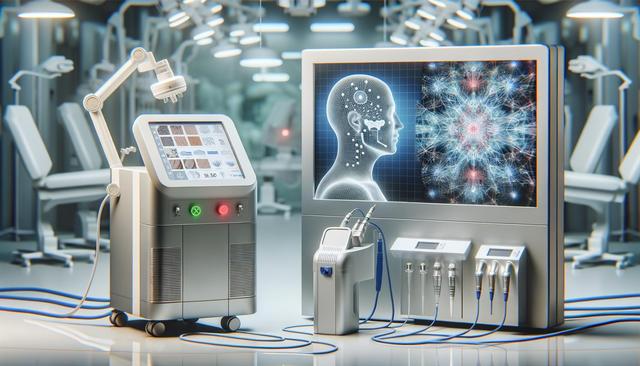Understanding Laser Skin Tightening and How It Works
Laser skin tightening is a non-invasive cosmetic procedure that uses focused light energy to stimulate collagen production deep within the skin. As we age, collagen levels naturally decline, leading to sagging, fine lines, and a loss of skin elasticity. Laser treatments, particularly those involving CO2 laser technology, offer a scientifically advanced approach to counteract these aging effects. The treatment targets the dermal layers without damaging the surface, making it a preferred option among various non-surgical anti-aging solutions.
The CO2 laser skin treatment operates by delivering precise pulses of energy to the skin, creating controlled micro-injuries that trigger the body’s natural healing response. This process helps promote new collagen and elastin formation, which are essential components for firm, youthful skin. Over time, the treated areas appear tighter, smoother, and more evenly toned.
CO2 laser technology is often used on areas like the face, neck, and décolletage, but it can also be applied to hands and other areas prone to aging. The precision of CO2 lasers allows dermatology professionals to tailor the depth and intensity of the treatment to the patient’s specific skin type and condition.
Key Benefits of CO2 Laser Skin Treatment
There are several notable advantages to choosing CO2 laser treatments for skin tightening and rejuvenation. These benefits are not only cosmetic but also contribute to long-term skin health. Here are a few of the most recognized advantages:
- Stimulates natural collagen production for firmer skin
- Reduces the appearance of fine lines, wrinkles, and age spots
- Improves skin tone, texture, and overall radiance
- Can address acne scars and other skin imperfections
- Minimally invasive with short recovery times
Patients who undergo laser skin treatment often report a noticeable improvement in their skin’s tightness and smoothness within weeks of the procedure. While results may vary depending on individual skin conditions and post-treatment care, the long-lasting results make it a popular option for those seeking gradual, natural-looking rejuvenation.
What to Expect During and After the Procedure
Laser skin tightening procedures typically begin with a consultation to assess the skin’s condition and customize the treatment plan. On the day of the procedure, a topical anesthetic may be applied to minimize discomfort. The treatment session can last anywhere from 30 minutes to two hours depending on the area being treated and the intensity of the laser settings.
After the procedure, patients may experience mild redness, swelling, or a sunburn-like sensation, which usually subsides within a few days. It’s important to follow aftercare instructions provided by the dermatology professional, which may include:
- Applying soothing ointments or moisturizers
- Avoiding direct sun exposure
- Using sunscreen with high SPF daily
- Keeping the treated area clean and protected
Most individuals can resume normal activities shortly after the procedure, although some may prefer to take a few days off for recovery, especially after more intensive sessions. As collagen continues to rebuild over several weeks, the full benefits of the laser skin treatment become more apparent.
Advances in Dermatology and Technology Across the USA
Across the USA, dermatology clinics are embracing advanced technologies like CO2 laser treatments to offer patients safer, more effective skin rejuvenation options. With continued research and innovation in medical aesthetics, laser devices have become more precise, making the procedures more accessible to a wider range of skin types and tones.
Many clinics now use fractionated CO2 lasers, which treat only a fraction of the skin at a time. This approach promotes faster healing while still delivering excellent results. The combination of safety, customization, and efficacy has made laser skin tightening a valued addition to modern dermatology practices.
In addition to traditional applications, new developments include combining CO2 laser treatments with other skin therapies such as microneedling or PRP (platelet-rich plasma) therapy to enhance outcomes further. These integrated approaches are gaining popularity for their ability to address multiple skin concerns in a single treatment plan.
Is Laser Skin Tightening Right for You?
Laser skin tightening, including CO2 laser treatments, is generally suitable for individuals experiencing mild to moderate skin laxity, uneven texture, or early signs of aging. It can be an effective preventive approach for those in their 30s and 40s and a rejuvenating option for older adults looking to improve skin firmness without surgery.
However, it’s important to have realistic expectations and consult with a qualified dermatology professional to determine if this treatment aligns with your skin goals. Factors such as skin type, medical history, and lifestyle habits will influence the results and suitability of the procedure.
Laser skin treatment is not a one-size-fits-all solution. A personalized plan, developed by a licensed specialist, ensures the safest and most effective outcome. If you’re considering non-invasive options to support long-term skin health and combat visible signs of aging, CO2 laser technology may be worth exploring.
Conclusion: A Modern Approach to Skin Rejuvenation
Laser skin tightening offers a modern, science-backed approach to anti-aging that appeals to many individuals seeking non-surgical solutions. With the benefits of CO2 laser skin treatment ranging from improved skin texture to enhanced firmness, it’s a promising option for those looking to maintain a youthful appearance over time. By choosing a reputable provider and staying informed about the treatment process, patients can make educated decisions that support their skincare goals and overall confidence.



Leave a Reply